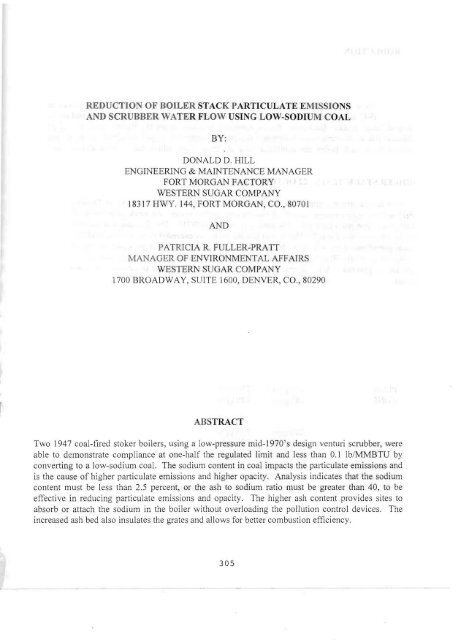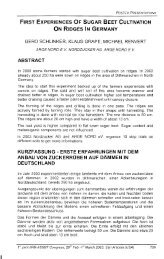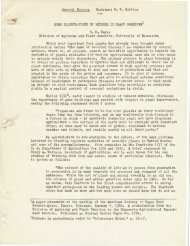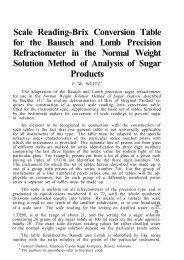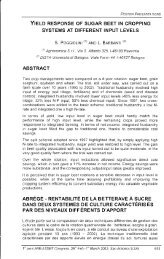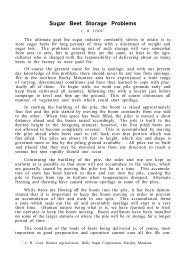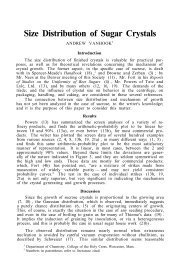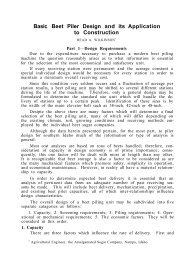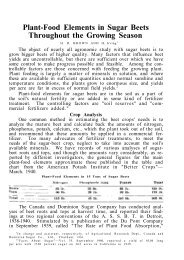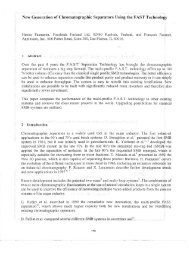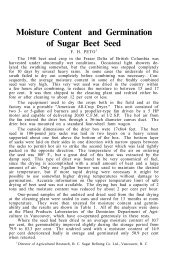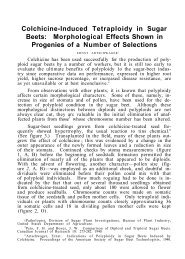reduction of boiler stack particulate emissions and scrubber water ...
reduction of boiler stack particulate emissions and scrubber water ...
reduction of boiler stack particulate emissions and scrubber water ...
Create successful ePaper yourself
Turn your PDF publications into a flip-book with our unique Google optimized e-Paper software.
REDUCTION OF BOILER STACK PARTICULATE EMISSIONS <br />
AND SCRUBBER WATER FLOW USING LOW-SODIUM COAL <br />
BY: <br />
DONALD D. HILL <br />
ENGINEERlNG & MAINTENANCE MANAGER <br />
FORT MORGAN FACTORY <br />
WESTERN SUGAR COMPANY <br />
18317 HWY. 144, FORT MORGAN, CO., 80701 <br />
AND <br />
PATRICIA R. FULLER-PRATT <br />
MANAGER OF ENVIRONMENTAL AFFAIRS <br />
WESTERN SUGAR COMPANY <br />
1700 BROADWAY, SUITE 1600, DENVER, CO., 80290 <br />
ABSTRACT<br />
Two 1947 coal-fired stoker <strong>boiler</strong>s, using a low-pressure mid-1970's design venturi <strong>scrubber</strong>, were<br />
able to demonstrate compliance at one-half the regulated limit <strong>and</strong> less than 0.1 Ib/MMBTU by<br />
converting to a low-sodium coal. The sodium content in coal impacts the <strong>particulate</strong> <strong>emissions</strong> <strong>and</strong><br />
is the cause <strong>of</strong> higher <strong>particulate</strong> <strong>emissions</strong> <strong>and</strong> higher opacity. Analysis indicates that the sodium<br />
content must be less than 2.5 percent, or the ash to sodium ratio must be greater than 40, to be<br />
effective in reducing <strong>particulate</strong> <strong>emissions</strong> <strong>and</strong> opacity. The higher ash content provides sites to<br />
absorb or attach the sodium in the <strong>boiler</strong> without overloading the pollution control devices. The<br />
increased ash bed also insulates the grates <strong>and</strong> allows for better combustion efficiency.<br />
305
INTRODUCTION<br />
Voluntary compliance tests for <strong>particulate</strong> <strong>emissions</strong> were performed in October <strong>of</strong> 1995 at the<br />
Western Sugar Company's Fort Morgan sugar beet processing plant.<br />
The <strong>boiler</strong>house contains two Babcock & Wilcox stoker-fired <strong>boiler</strong>s. The units were placed in<br />
service in 1947 <strong>and</strong>, except for a short time using natural gas, have used Detroit Stoker stokers as<br />
the coal-firing system. Each <strong>boiler</strong> has an American St<strong>and</strong>ard Series 361 fly-ash collector <strong>and</strong> an<br />
in-house (Great Western Sugar Company) designed low-pressure venturi <strong>scrubber</strong>. Exhaust gas<br />
streams from each <strong>boiler</strong> are combined in a common <strong>stack</strong> which has a chevron-type mist<br />
eliminator.<br />
BOILER STACK TESTS - 22 OCTOBER 1995<br />
Normal intercampaign maintenance was performed on the <strong>boiler</strong> equipment <strong>and</strong> the Detroit Stoker<br />
field service representative "tuned" the <strong>boiler</strong> combustion system the week prior to the October<br />
1995 tests. The <strong>particulate</strong> emission limit is 0.14 Ib.lMMBTU. The first day's test results were<br />
under the limit (see Table 1). The second day the limit was exceeded twice <strong>and</strong> the average for the<br />
three compliance runs was 0.16 Ib.lMMBTU. The information was presented to the State <strong>of</strong><br />
Colorado under the State's program <strong>of</strong> voluntary disclosure <strong>and</strong> a second test was scheduled as<br />
quickly as possible. Also, several <strong>boiler</strong> consultants were contacted to observe the compliance<br />
retest.<br />
TABLE 1 <br />
OCTOBER STACK TESTS <br />
PARTICULATE EMISSIONS <br />
OCTOBER 2 AND 3; 1995 <br />
ITEM RUNNO.1 RUNNO.2 RUN NO.3 AVERAGE<br />
Boiler No.1<br />
PLUG<br />
CONE<br />
250 gpm<br />
285 gpm<br />
250 gpm<br />
280 gpm<br />
250 gpm<br />
280 gpm<br />
250 gpm<br />
282 gpm<br />
Boiler No.2<br />
PLUG<br />
CONE<br />
280 gpm<br />
260 gpm<br />
275 gpm<br />
250 gpm<br />
275 gpm<br />
250 gpm<br />
277 gpm<br />
253 gpm<br />
PARTICULATE<br />
EMISSIONS<br />
(lb.lMMBTU)<br />
0.128<br />
0.189<br />
0.163<br />
0.160<br />
306 <br />
- - .... - -
RETESTS - 15 NOVEMBER 1995<br />
The coal supplier provided a consultant to review the coal as-delivered <strong>and</strong> as-fired, <strong>and</strong> also to<br />
observe the <strong>boiler</strong> operation. Detroit Stoker provided the same technician who was on site in<br />
October to "tune" the <strong>boiler</strong>s. He also observed the <strong>boiler</strong> operation during the tests in order to<br />
advise us if any mechanical problems may have developed. A <strong>scrubber</strong> manufacturer was contacted<br />
to observe the venturi <strong>scrubber</strong> operation during the tests <strong>and</strong> to inspect it prior to the tests. This<br />
individual had been previously employed as a "<strong>stack</strong> tester" <strong>and</strong> also observed the <strong>stack</strong> testing<br />
company during the compliance runs.<br />
The November tests were run with more <strong>scrubber</strong> <strong>water</strong> flow, higher pressure drops across the<br />
<strong>scrubber</strong>, but no "h<strong>and</strong>s-on" operation by any <strong>of</strong> the consultants. The average <strong>of</strong> the three<br />
compliance runs for <strong>particulate</strong>s was 0.271 Ib.lMMBTU (see Table 2), which is nearly twice the<br />
permitted limit.<br />
TABLE 2<br />
NOVEMBER STACK TESTS<br />
P ARTICULATE EMISSIONS<br />
NOVEMBER 15 AND 16, 1995<br />
ITEM RUN NO.] RUN NO. 2 RUN NO.3 AVERAGE<br />
Boiler No.1<br />
PLUG 335 gpm 334 gpm 333 gpm 334 gpm<br />
CONE 340 gpm 338 gpm 337 gpm 338 gpm<br />
Boiler No.2<br />
PLUG 323 gpm 321 gpm 328 gpm 324 gpm<br />
CONE 335 gpm 332 gpm 332 gpm 333 gpm<br />
PARTICULATE<br />
EMISSIONS<br />
(lb. / MMBTU) 0.269 0.280 0.265 0.271<br />
SODIUM<br />
EMISSIONS<br />
(lb. / MMBTU) 0.110 0.123 0.122 0.118<br />
SODIUM OXIDE<br />
(% in ASH) 8.015 6.685 8.05 7.58<br />
During the tests, the opacity <strong>of</strong> the <strong>stack</strong> was observed (not using Method 9) by all the consultants<br />
<strong>and</strong> a "blue haze" was evident after the vapor break <strong>of</strong> the "plume". The coal consultant suggested<br />
that the "blue haze" might be due to sodium <strong>and</strong> was a condition he had observed before with<br />
Northern Powder River Basin coal. The <strong>scrubber</strong> consultant agreed that this was possible, <strong>and</strong><br />
307
suggested that a sub-micron sodium fume would pass through a low-pressure venturi <strong>scrubber</strong>. He<br />
suggested that we analyze the <strong>particulate</strong> catch for "sodium". This analysis by the <strong>stack</strong> testing<br />
company averaged 0.118 lb. Sodium/MMBTU, which is nearly 90% <strong>of</strong> the permitted limit. An<br />
analysis <strong>of</strong> the coal as-fired for sodium oxide, averaged 7.58% sodium oxide in the ash. When the<br />
coal shipments were reviewed for the 1995-1996 campaign (see Table 3), the percent sodium in the<br />
ash during the October test was around 4.0% <strong>and</strong> the highest values -- 7.0% to 8.0% -- occurred<br />
during the November test. The consultants agreed that the <strong>boiler</strong>s were performing correctly <strong>and</strong><br />
that the coal was the biggest contributor to the problem.<br />
TABLE 3<br />
COAL SIDPMENT DATA FOR 1995-1996 CAMPAIGN<br />
Date <strong>of</strong> lb/MMBTU % Ash % Sodium Calculated % Sulfur<br />
Shipment<br />
Ratio<br />
9/17/95 9,309 4.37 4.5 22.22 0.33<br />
9/24/95 9421 4.55 4.95 20.2 0.41<br />
9/29/95 9379 4.58 4.5 22.22 0.34<br />
10/3/95 9427 3.97 4.21 23.75 0.37<br />
10/4/95 9356 4.29 4.45 22.47 0.35<br />
10/11 /95 9438 3.79 5.32 18.8 0.35<br />
10113/95 9467 3.85 4.41 22.68 0.34<br />
10118/95 9244 4.5 3.91 25.58 0.33<br />
10/22/95 9553 3.98 5.19 19.27 0.3<br />
10/28/95 9407 3.82 4.42 22.62 0.34<br />
10/30/95 9368 4.13 6.74 14.84 0.3<br />
10/30/95 9377 4.71 6.44 15.53 0.36<br />
1114/95 9420 4.15 7.07 14.14 0.35<br />
11111195 9475 3.74 7.89 12.67 0.32<br />
11116/95 9453 3.96 8.35 1l.98 0.34<br />
11119/95 9612 4.42 5.19 19.27 0.33<br />
11122/95 9485 4.08 5.83 17.15 0.34<br />
11127/95 9328 4.47 4.62 2l.64 0.34<br />
12/2/95 9383 4.07 5.02 19.92 0.3<br />
12/7/95 9463 4.46 5.63 17.76 0.45<br />
12111/95 9222 4.37 6.57 15.22 0.33<br />
12114/95 9424 3.81 7.38 13.55 0.33<br />
12117/95 8795 4.6 1.47 68.03 0.15<br />
12/22/95 9442 3.6 5.26 19.01 0.32<br />
12/26/95 9434 3.94 5.09 19.65 0.35<br />
AVERAGES 9387 4.17 5.38 20.81 0.33<br />
308<br />
_ .-._---_..- .-... - -
ENGINEERING TESTS - 21 DECEMBER 1995<br />
A source for ]ow-sodium coal was found in the Southern Powder River Basin <strong>and</strong> a test burn <strong>and</strong><br />
compliance test were arranged for December 21, 1995. These tests were not full compliance tests<br />
but were engineering-level tests only meant to test the "sodium in the coal" theory. Also, these tests<br />
were observed by a representative <strong>of</strong> the Colorado Department <strong>of</strong> PubEc Health <strong>and</strong> Environment,<br />
as were the November tests. However, no consultants were present. The <strong>scrubber</strong> <strong>water</strong> flows were<br />
returned to the levels <strong>of</strong> the October test (see Table 4) <strong>and</strong> the <strong>particulate</strong> <strong>emissions</strong> were an average<br />
<strong>of</strong> 0.09 IbIMMBTU, which is ]ess than 65% <strong>of</strong> the permit limit <strong>of</strong> 0.14 Ib.lMMBTU. Unfortunately,<br />
we were ten days away from the end <strong>of</strong> campaign <strong>and</strong> a full compliance test could not be scheduled<br />
until the start <strong>of</strong> the 1996 -1997 campaign.<br />
TABLE 4<br />
DECEMBER STACK TESTS ("ENGINEERING TESTS") <br />
PARTICULATE EMISSIONS <br />
DECEMBER 21, 1995 <br />
ITEM RUN NO.1 RUN NO.2 AVERAGE<br />
Boiler No.1<br />
PLUG 200 gpm 200 gpm 200 gpm<br />
CONE 200 gpm 200 gpm 200 gpm<br />
Boiler No.2<br />
PLUG 195 gpm 200 gpm 198 gpm<br />
CONE 200 gpm 200 gpm 200 gpm<br />
PARTICULATE<br />
EMISSION S<br />
(lb.lMMBTU) 0.087 0.085 0.09<br />
CALCULATION MISCONCEPTION<br />
Research at another Western Sugar factory regarding opacity suggested that an Ash to Sodium-inthe-Ash<br />
ratio <strong>of</strong> 48 or better at that factory would produce an opacity <strong>of</strong> about 10%. The consultant<br />
suggested a b ~ end <strong>of</strong> "high" <strong>and</strong> "low" sodium coals to reduce opacity at that factory. However,<br />
that consultant felt that sodium wou1d not contribute much to <strong>particulate</strong> <strong>emissions</strong> (which proved<br />
incorrect in our testing at Ft. Morgan).<br />
The consultant's report attempted to establish the Ash/Sodium ratio by using lb. AshlMMBTU <strong>and</strong><br />
lb. Sodium/MMBTU. Basically, this is mathematically incorrect. In order to calculate each <strong>of</strong> these<br />
numbers <strong>and</strong> then take the ratio you have essentially canceled out the units <strong>and</strong> the ratio is really<br />
one (1) divided by the Sodium in the Ash percentage expressed as a number, i.e. 2.5% Sodium in<br />
the Ash is equal to 0.025. Therefore, 1/0.025 = 40. For the Ft. Morgan factory, we developed a<br />
309
conservative estimate that a coal with an Ash to Sodium in the Ash ratio <strong>of</strong> greater than 40, or a<br />
Sodium in the Ash content <strong>of</strong> less than 2.5 %, would achieve compliance.<br />
COMPLIANCE AND ENGINEERING TESTS - 22 OCTOBER 1996<br />
A low-sodium Southern Powder Ri ver Basin coal was contracted for the 1996-1997 beet campaign.<br />
A compliance test was conducted on October 22, 1996 (see Tabl 5). The results averaged 0.072<br />
Ib.lMMBTU, which is well below the 0.14 Ib.lMMBTU <strong>particulate</strong> emission limit.<br />
TABLES<br />
OCTOBER 1996 COMPLIANCE DEMONSTRATION STACK TEST<br />
PARTICULATE EMISSIONS<br />
OCTOBER 22,1996<br />
ITEM RUN NO.1 RUN NO.2 RUN NO.3 AVERAGE<br />
Boiler No.1<br />
PLUG 210 gpm 211 gpm 210 gpm 210 gpm<br />
CONE 208 gpm 209 gpm 207 gpm 208 gpm<br />
Scrubber Diff. Press. 5.8 in. H 2 O 5.6 in H 2 O 5.9 in H 2 O 5.8 in H 2 O<br />
Boiler No.2<br />
PLUG 199 gpm 214 gpm 211 gpm 208 gpm<br />
CONE 199 gpm 204 gpm 214 gpm 206 gpm<br />
Scrubber Diff. Press 5.6 in. H 2 O 5.6 in H 2 O 5.6 in H 2 O 5.6 in H 2 O<br />
PARTICULATE <br />
EMISSIONS <br />
(lb.lMMBTU) 0.079 0.066 0.070 0.072 <br />
After the compliance tests were completed, the <strong>water</strong> flows to the <strong>scrubber</strong> plug <strong>and</strong> cone <strong>and</strong> the<br />
venturi plug placement were varied in order to establish parameters which could be tested in order<br />
to prove compliance using parmetric monitoring for the Title V Operating Permit. A total <strong>of</strong> eight<br />
engineering tests were performed at four different <strong>water</strong> flows <strong>and</strong> lor pressure differentials (two<br />
tests at each level).<br />
~<br />
The <strong>water</strong> flowrates for the plug <strong>and</strong> cone <strong>of</strong> the venturi were varied from 200 gpm to 150 gpm to<br />
100 gpm <strong>and</strong> the pressure drop was changed from 5.0, 4.0, to 3.0 in. H 2 0. The idea was to vary the<br />
<strong>water</strong> flow <strong>and</strong> hold the pressure drop constant to simulate a condition <strong>of</strong> loss/<strong>reduction</strong> <strong>of</strong> <strong>water</strong><br />
flow (pump belt slippage, pat1ial blockage or some other reason). The pressure drop was varied<br />
while holding the <strong>water</strong> flow constant in order to simulate a loss in air flow (a mechanical problem<br />
with the fans or their steam-turbine drivers, a damper problem or some other reason). The<br />
variations all worked, except the 3.0 in. H 2 0 pressure drop setting, which required decreasing the<br />
<strong>water</strong> flow by 50 gpm in order to get the pressure to drop even though the venturi plug had been<br />
lowered to its lowest point. As the results show (see Table 6), the <strong>water</strong> flow variation tests had<br />
310
<strong>particulate</strong> <strong>emissions</strong> <strong>of</strong> 0.072, 0.076 <strong>and</strong> 0.078 lb.lMMBTU <strong>and</strong> the pressure drop <strong>particulate</strong><br />
emission rates were 0.072, 0.09 <strong>and</strong> 0.088 lb.lMMBTU.<br />
TABLE 6<br />
OCTOBER 1996 "ENGINEERING" STACK TEST<br />
PARTICULATE EMISSIONS VARYING WATER IiLOW & PRESSURE DIFFERENTIAL<br />
OCTOBER 23 & 24, 1996<br />
VARYING WATER FLOW<br />
VARYING PRESSURE<br />
ITEM RUN NO.1 RUN NO.2 RUN NO.3 RUN NO.4<br />
Scrubber Water Flow<br />
PLUG & CONE #1 307 gpm 214 gpm 414 gpm 300 gpm *<br />
PLUG & CONE #2 309 gpm 211 gpm 412 gpm 296 gpm *<br />
Scrubber Differential Pressure<br />
BOILER N O. 1 5.5 in. H 2 0 4.9 in H 2 0 4.4 in H 2 0 3.4 in H 2 0<br />
BOILER N O. 2 5.3 in. H 2 0 5.0 in H 2 0 4.1 in H 2 0 3.3 in H 2 0<br />
Particulate Emissions<br />
(lb.lMMBTU) 0.079 0.066 0.070 0.072<br />
These engineering tests showed that there is a wide operating window for the <strong>scrubber</strong>s when using<br />
a low-sodium coal. It appears that low <strong>water</strong> flowrate <strong>and</strong> a small pressure drop will still allow the<br />
<strong>boiler</strong>s to operate below their <strong>particulate</strong> permit limit <strong>of</strong> 0.14 Ib.lMMBTU.<br />
CONCLUSIONS AND BENEFITS<br />
The Fort Morgan factory is in compliance with <strong>boiler</strong> <strong>particulate</strong> limits when it uses low-sodium<br />
coal. The Fort Morgan factory can successfully demonstrate on-going compliance by monitoring<br />
the following parameters:<br />
• COAL SUPPLY<br />
Maintain a record <strong>of</strong> the coal analysis <strong>of</strong> each shipment <strong>of</strong> coal to the factory <strong>and</strong> verify<br />
that it is less than 2.5% Sodium in the Ash. (Ash/Sodium ratio <strong>of</strong> greater than 40).<br />
• SCRUBBER WATER FLOW<br />
Keep the <strong>water</strong> flow to each venturi plug above 100 gpm <strong>and</strong> 100 gpm to each venturi<br />
cone. These are recorded continuously on a strip chart recorder.<br />
311
• SCRUBBER PRESSURE DIFFERENTIAL <br />
Set the venturi plug at a point to maintain at least 2.5 in. H 2<br />
0 or more <strong>of</strong> pressure drop for<br />
each venturi <strong>scrubber</strong>. The pressure drops are also continuously recorded on strip chart<br />
recorders in the <strong>boiler</strong> control room.<br />
BENEFITS<br />
1. The original <strong>scrubber</strong> <strong>water</strong> flowrates had a "design" need for 800 gpm for each <strong>scrubber</strong><br />
system or 1600 gpm for both, which all ended up in the ash pond. This flow has now<br />
been reduced to 200 gpm to 250 gpm for each system or 400 gpm to 500 gpm, a total<br />
savings <strong>of</strong> 1100 + gpm.<br />
2. By having a thicker ash bed, the combustion air entry points can be redirected to have<br />
the undergrate air decreased as the grates are better insulated <strong>and</strong> the overfire air<br />
increased to "lower" the flame <strong>and</strong> improve 02 addition in the suspended- burning zone.<br />
3. With better air flow distribution, even though the BTU content <strong>of</strong> the low-sodium coal is<br />
less than that <strong>of</strong> the previous higher-sodium coal, the combustion efficiency has<br />
improved <strong>and</strong> coal consumption is less (about 30 + tons per day).<br />
4. Post campaign <strong>boiler</strong> cleanup is easier <strong>and</strong> quicker, as the lower sodium coal does not<br />
"slag" as much <strong>and</strong> the slag that does form appears s<strong>of</strong>ter <strong>and</strong> easier to remove.<br />
312


